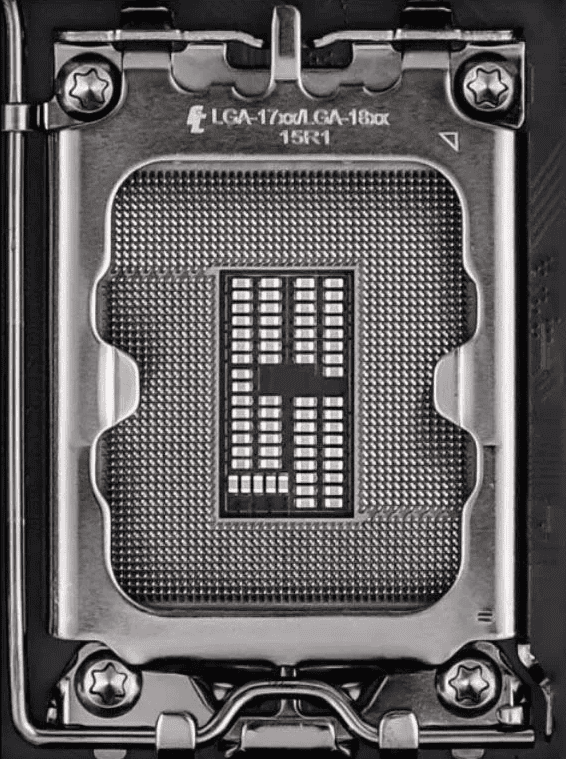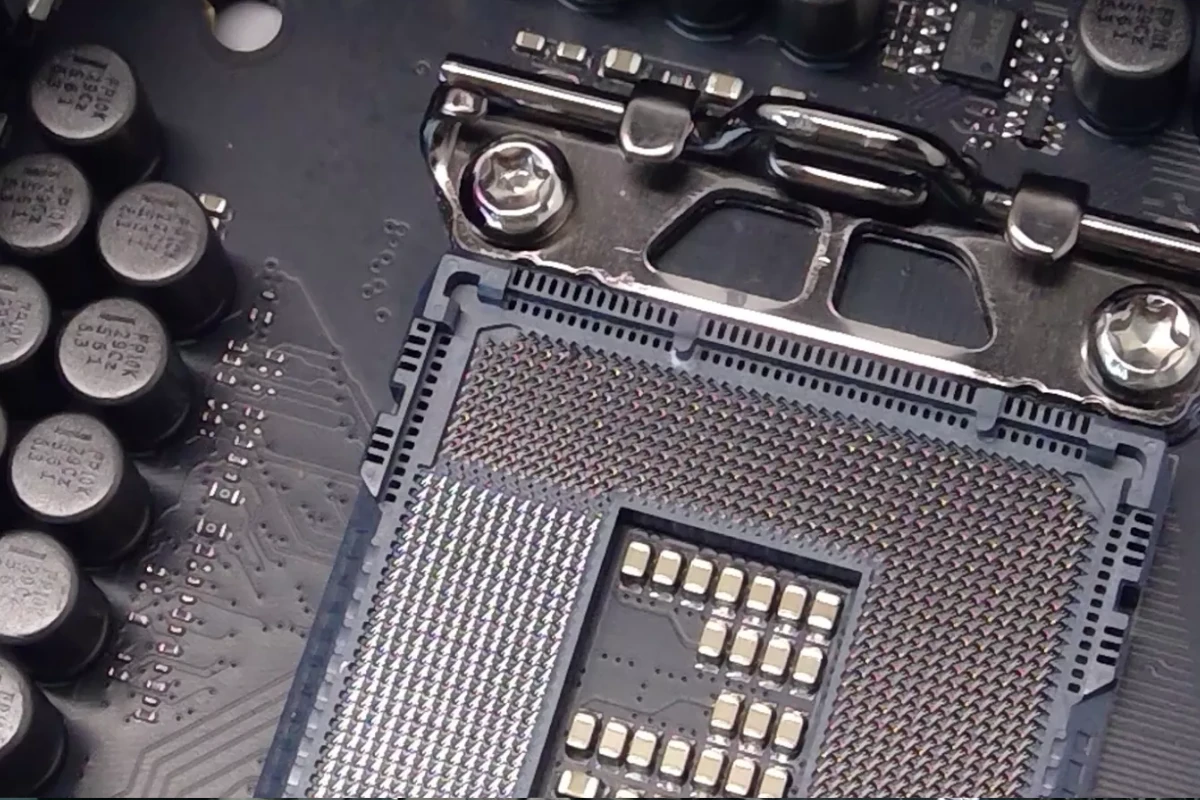The CPU socket is a crucial part of modern computing. It connects the processor to the motherboard and allows it to communicate with other computer components. Intel has been developing CPU sockets since the early days of computing, constantly improving performance and adding new features with each iteration. The company’s adaptability to changing technological landscapes is evident in the significant milestones marking the evolution of Intel CPU sockets. For example, the release of the LGA 1156 socket in 2008 was a turning point, introducing designs for new lines of processors. Looking ahead to the anticipated LGA 1851 socket set for release in 2024, Intel continues to innovate, aiming to support next-generation processors like the 15th Gen Arrow Lake S CPU.
A Guide to Intel’s Processor Sockets
Intel has consistently released new CPU sockets over the years to support newer and more powerful processors. Here’s a look at the history of Intel’s socket releases and their significance:
The Early Years
Intel’s earliest processors used simple DIP (Dual In-line Package) sockets on motherboards. However, the move to more powerful processors led to the development of more complex and specialized sockets.
The Socket Era
- Socket 7 (1995): Supported Pentium, Pentium II, Pentium III, and Celeron processors. One of the most popular early sockets.
- Socket 370 (1999): Designed for Celeron and later Pentium III processors.
- Socket 478 (2000): Supported a wide range of Pentium 4 and Celeron processors, offering a significant increase in pin count compared to previous sockets.
The LGA Era
Intel introduced Land Grid Array (LGA) sockets which eliminated pins on the processor, transferring them to the motherboard instead. This reduced the risk of damage to the processor during installation.
- LGA 775 (2004): Introduced with Pentium 4 processors and also supported Pentium D and some Core 2 Duo processors.
- LGA 1156 (2008): The first socket for the Core i-series processors.
- LGA 1366 (2008): A high-end socket designed for the first generation of Core i7 processors (Nehalem architecture)
- LGA 1155 (2011): Supported 2nd and 3rd generation Intel Core processors (Sandy Bridge and Ivy Bridge architectures).
- LGA 1150 (2013): Designed for 4th and 5th generation Intel Core processors (Haswell and Broadwell architectures).
- LGA 2011 (2011): A large socket for high-end desktop and server processors. It supported several generations of Core i7 and Xeon CPUs
- LGA 1200 (2020): Socket for 10th and 11th-generation Intel Core processors (Comet Lake and Rocket Lake architectures).
- LGA 1700 (2021): Released for the current 12th and 13th generation Intel Core processors (Alder Lake and Raptor Lake architectures).
Upcoming Releases
- LGA 1851 (Expected 2024/2025): Anticipated to support Intel’s future Meteor Lake and Arrow Lake processors.
Socket Compatibility Table
| Socket Name | Year Released | Processor Families Supported |
|---|---|---|
| Socket 7 | 1995 | Pentium, Pentium II, Pentium III, Celeron |
| Socket 370 | 1999 | Celeron, Pentium III |
| Socket 478 | 2000 | Pentium 4, Celeron |
| LGA 775 | 2004 | Pentium 4, Pentium D, Core 2 Duo |
| LGA 1156 | 2008 | 1st Generation Core i3/i5/i7 |
| LGA 1366 | 2008 | 1st Generation Core i7 (Nehalem) |
| LGA 1155 | 2011 | 2nd and 3rd Gen Core i3/i5/i7 |
| LGA 1150 | 2013 | 4th and 5th Gen Core i3/i5/i7 |
| LGA 2011 | 2011 | Core i7 (Sandy Bridge-E, Ivy Bridge-E, Haswell-E), Xeon |
| LGA 1200 | 2020 | 10th and 11th Gen Core i3/i5/i7/i9 |
| LGA 1700 | 2021 | 12th and 13th Gen Core i3/i5/i7/i9 |
| LGA 1851 | ~2024/2025 (Expected) | Future Intel Meteor Lake and Arrow Lake CPUs |
Important Note: Always check your motherboard documentation for specific CPU compatibility information before making a purchase.

Key Takeaways
- Intel CPU sockets connect processors to motherboards, enabling communication within the computer.
- Socket designs evolve with technology, influencing performance and compatibility.
- Future releases, like the LGA 1851 socket, continue the trend of innovation for next-gen processors.
Evolution of Intel CPU Sockets
Intel has produced a variety of CPU sockets to complement the advancements of its processors. Over time, these sockets have evolved in design and functionality, adapting to the needs of different generations of CPUs.
Early Architectures and Sockets
The beginning of Intel’s journey with CPU sockets dates back to the late 1970s with the DIP sockets for the Intel 8086 and 8088 microprocessors. The company later released more advanced sockets such as Socket 1, Socket 2, and Socket 3 to support the 80486 and early Pentium processors. These sockets represent the initial steps in a path towards more versatile and powerful computing hardware.
Advancements in CPU Sockets
In the late 1990s, Intel introduced Socket 7 and then swiftly moved to the advanced Slot 1 design for Pentium II and Pentium III processors. As the need for faster data exchange rates grew, Intel developed the LGA 775 socket for the Pentium 4 and Core 2 Duo processors. This socket brought significant improvements in power delivery and cooling efficiency. Following sockets like LGA 1155, LGA 1156, LGA 1150, and LGA 1151 witnessed the arrival of the Core processor series, representing major leaps in performance.
Intel’s High-End and Server Sockets
For high-end desktops and servers, Intel introduced sockets such as LGA 2011 for Xeon processors and LGA 1700 for the most recent CPU families. These sockets cater to the rigorous demands of professional computing environments. Socket F, also known as LGA 3647, is designated for Xeon processors and is engineered to handle the high-performance requirements of servers and workstations.
Intel Socket Release Chart (Desktop Processors)
| CPU Socket | Release Date | Processor Generation | Compatible Processors |
|---|---|---|---|
| PGA 132 | 1989 | 80486 | 80486SX, 80486DX |
| Socket 7 | 1995 | Pentium, Pentium II, Pentium III, Celeron | Pentium Classic, Pentium Pro, Pentium II, Pentium III, Celeron |
| Socket 370 | 1999 | Celeron, Pentium III | Celeron 300A, Pentium III 450 |
| Socket 478 | 2000 | Pentium 4, Celeron | Pentium 4 1.3 GHz, Celeron 1.1 GHz |
| LGA 775 | April 2004 | Pentium 4, Pentium D, Core 2 Duo, Core 2 Quad, Celeron D, Celeron 4 | Pentium 4 505, Pentium D 925, Core 2 Duo E6300, Core 2 Quad Q6600, Celeron D 341, Celeron 4 530 |
| LGA 1156 | May 2009 | Core i3, Core i5, Core i7 | Core i3-530, Core i5-750, Core i7-870 |
| LGA 1155 | January 2011 | Core i3, Core i5, Core i7, Pentium, Celeron | Core i3-2100, Core i5-2500, Core i7-2600, Pentium G840, Celeron G1100 |
| LGA 1150 | June 2013 | Core i3, Core i5, Core i7, Pentium, Celeron | Core i3-4130, Core i5-4440, Core i7-4770, Pentium G3220, Celeron G1820 |
| LGA 1151 | September 2015 | Core i3, Core i5, Core i7, Pentium, Celeron | Core i3-6100, Core i5-6500, Core i7-6700, Pentium G4400, Celeron G3900 |
| LGA 1200 | May 2020 | Core i3, Core i5, Core i7, Pentium, Celeron | Core i3-10100, Core i5-10400, Core i7-10700, Pentium G4620, Celeron G5900 |
| LGA 1700 | November 2021 | Core i3, Core i5, Core i7, Core i9 | Core i3-12100, Core i5-12600, Core i7-12700, Core i9-12900 |
| LGA 1851 | Late 2024 | Intel ‘Arrow Lake’ Processors | To be announced |
Technical Specifications and Features
Intel CPU sockets have evolved to support the increasing demands of modern computing. This section explores the architecture, compatibility, and features that define current Intel processors.
Socket Architecture and Chipset Compatibility
Intel sockets connect CPUs to motherboards, with each socket type designed for specific Intel Core and Xeon processors. For instance, LGA 1200 sockets work with 10th generation Core processors. Compatibility with chipsets like Z390 and H310 depends on the CPU generation. Updates to the BIOS may be necessary to support new CPUs on older motherboards.
Peripheral Technology Support
Modern Intel sockets support advanced peripherals. They include features like PCIe 4.0 for faster graphics and storage. They work with DDR4 memory, bringing speedy and efficient performance to PCs. Intel aims to improve user experience by enabling support for the latest technologies in displays, storage, and networking.
CPU Capabilities and Innovation
Intel CPUs offer a range of capabilities from basic tasks to high-end gaming and professional work. Core counts, clock speeds, and cache sizes have grown to meet various market needs. Intel Core i3, i5, i7, and i9 series demonstrate a step-up approach in capabilities from entry-level to peak performance. Innovations like turbo boost and hyper-threading help these CPUs meet the demands of complex applications.
Industry Impact and Technology Trends
Intel’s CPU technology sets trends in the PC market. As gaming, creative work, and data science evolve, Intel responds with matching capabilities in their processors. Intel stays tuned with market needs, leading to CPUs that push limits in areas like multi-tasking and immersive gaming experiences.
Future Socket Developments
Looking forward, Intel continues to plan new socket designs to adapt to advancing technology. Intel’s roadmap includes next-generation platforms like Raptor Lake and Alder Lake. These future sockets may introduce compatibility with newer memory and speed standards, keeping pace with user demands for performance and reliability.
Frequently Asked Questions
In this section, we answer commonly asked questions about Intel CPU socket release history. We cover the timeline, socket list, and details about the latest and upcoming sockets.
What is the timeline for Intel CPU socket releases?
Intel has consistently introduced new CPU sockets over many years. Upgrades in technology and performance drive the release of newer socket types to match processor advancements.
Can you provide a list of Intel CPU sockets with their corresponding processor generations?
Yes. For example, LGA 1150 corresponds to the 4th and 5th Gen Intel Core processors. LGA 1151 is for 6th and 7th Gen, and LGA 1200 for 10th and 11th Gen. This is just a sample of the comprehensive list available.
What is the latest Intel CPU socket currently available?
The LGA 1700 socket is the most recent release from Intel, catering to the latest generation Intel Core processors.
How frequently does Intel introduce a new CPU socket?
Intel does not introduce new CPU sockets on a fixed schedule. Releases often depend on technological advances and market needs. Typically, new sockets appear every few years.
Which Intel CPU socket supports the 14th Gen processors?
Information about the 14th Gen processors and their supported sockets will be available once officially announced by Intel.
When was the LGA 1700 socket introduced by Intel?
Intel launched the LGA 1700 socket in 2021 to support their 12th Gen Alder Lake processors.







